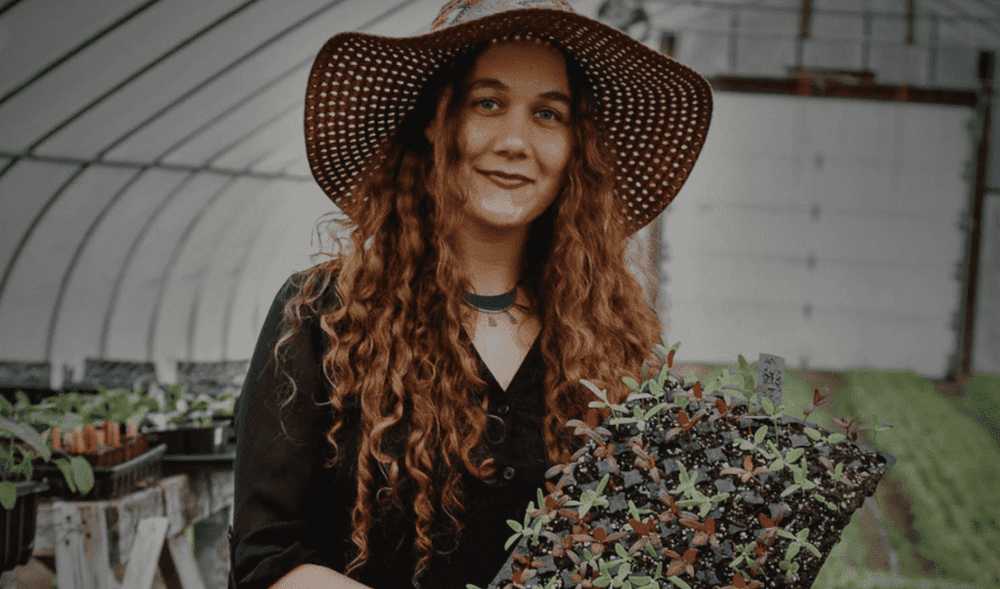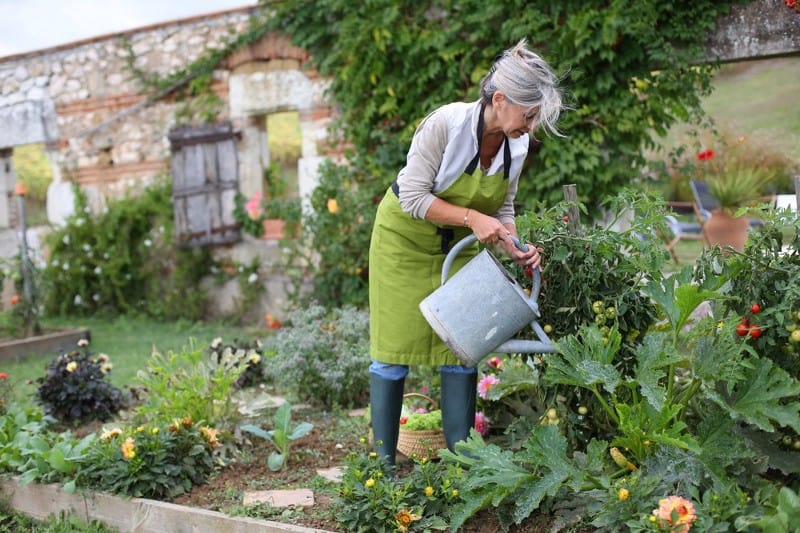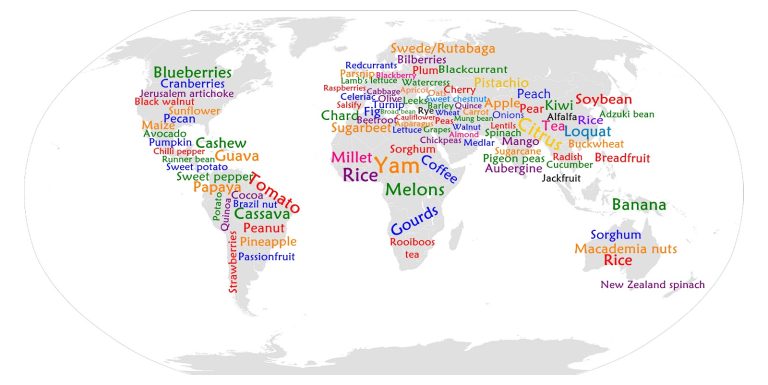
A curated collection of top-notch permaculture books by women you might not have heard about.
Women have a high rate of participation throughout permaculture, but aren’t proportionally represented in leadership roles. The spotlight often goes towards men while women who are organizing and farming get overlooked. This can make it more difficult to find the work out there that women have done. In researching this article I was surprised to find that any combination of words I could think to type in around women writers in permaculture found few, or oftentimes no results.
So, to make it easier for everyone to find these excellent resources, I’ve compiled a list of female authors and their books, some in the permaculture movement, some who may not identify as permaculture designers, but who still wrote important books for self-sufficiency and gardening.
Listed in alphabetical order, by author’s last name:
Jenni Blackmore: Permaculture For the Rest of Us: Abundant Living on Less Than an Acre
A very readable, personal account of her twenty years of trial and error farming in Nova Scotia. A great read for anyone who can’t afford a large farm in a sunny climate.
In addition to being a micro-farmer Jenni is also a painter and certified Permaculture Design Consultant. She lives on Quakadoodle Farm.
Catherine Bukowski: The Community Food Forests Handbook
Focusing on how to build and maintain a food forest project when working with a community of people. Focuses on the social aspects of a project and changes that occur in a group from the beginning to the end of a project. More info here.
Novella Carpenter: Farm City
An urban farming memoir set in Oakland that has contains many stories of her raising animals. In 2011 she was told by the city that she would need to close the farm but instead she was eventually able to get a Minor Conditional Use Permit. This allowed her to keep her more than 40 animals and inner city garden. She is currently an adjunct professor of Environmental Studies at the University of San Francisco. Here’s her blog.
Robin Clayfield: You Can Have Your Permaculture and Eat it Too
Robin has been teaching permaculture and in particular, the social aspects of permaculture, for more than 20 years. Her playful style complements a serious body of revolutionary work, well respected by fellow permies around the world. Her extensive website is here.
Rosalind Creasy: Edible Landscaping
While this is not technically a permaculture book it does address designing your outdoor landscape with edible plants instead of being only decorative and was highly influential when it was first published in 1982. Her work goes as far back as 1970. She has written several other books and appeared in many publications. Her website is a fantastic resource for edible landscaping tips.
Carol Deppe: The Resilient Gardener
Presents gardening techniques in disaster design, whether the disasters are financial or climate change related. A relevant book for our times. She has two other books, The Tao of Vegetable Gardening and Breed Your Own Vegetable Varieties. You can access many of her essays and articles on her website.
Kristeva Dowling: Chicken Poop for the Soul: A Year in Search of Food Sovereignty
A whimsical yet sincere book, detailing the adventures of a disenchanted yet highly creative Canadian, forging a path, literally and emotionally, to self-reliance. Find her on Facebook here.
Heather Jo Flores: Food Not Lawns
There are more than 50 Food Not Lawns chapters worldwide, mostly due to inspiration from this book. Heather makes the connection between gardening, activism, and community building, as tools for sustainabilty. Food Not Lawns is a great book for the urban dweller as well as country living. Heather also runs the Permaculture Women’s Guild, which offers an online permaculture design certificate course taught by 40 women.

Bonita Ford: Embers of Hope
Part memoir, part workbook, Embers of Hope encourages us to learn the facts, cope with our feelings about those facts, and then get out there and make the world a better place. It’s contemporary ecophilosophy at its finest, a landmark guidebook to navigating the end of the world and beyond, by way of the garden gate.
Jackie French: Backyard Self-Sufficiency
Jackie is a self-described “Australian author, ecologist, historian, dyslexic, honourary wombat.” She loves writing as much as she loves gardening, and she has written a bunch of books. Learn more here.
Vera Greutink: Edible Paradise
Vera lives on a 1/4 acre plot of land in the Netherlands where she has created her own edible paradise. In this book she shares her no dig permaculture techniques she has used for 15 years. Learn to grow a landscape of herbs, flowers, and vegetables as well as building compost. Also contains a monthly garden job guide.
Maddy Harland: Fertile Edges: Regenerating Land, Culture and Hope
Discusses the potential of use of permaculture principles in society alongside current events. She demonstrates those principles in contrast to the way things are usually done. She is also the editor of Permaculture Magazine.
Rachel Kaplan and K. Ruby Blume: Urban Homesteading
Focused on their own hands-on personal experience in an urban environment, this 2011 hands-on exploration connects to an ever-evolving blog, here.
Juliet Kemp: Permaculture in Pots: How to Grow Food in Small Urban Spaces
An excellent reference for anyone who doesn’t have good access to land, this book also provides ideas for making best use of vertical space and microclimates. Written in almanac format with a month-by-month list of suggestions. Juliet also writes fiction.
Looby Macnamara: People and Permaculture
This has been a very influential book because it was an early arrival in the discussion of social permaculture, taking permaculture ethics and principals and applying them to our interactions with each other, ourselves, our families and society. It also contains many useful activities. Looby also wrote 7 Ways to Think Differently and is currently working on her next book Activating Cultural Emergence. She also runs Applewood, a 20 acre demonstration and education center.
Rosemary Morrow: Earth Users Guide To Permaculture
This book can be found on most lists for best permaculture books. It is a practical permaculture design guide good for use on whatever sized plot of land you are working with. Contains information on water use, managing pests and wildlife, and much more. Published in 1993 it is older than most books on this list. Rosemary began teaching permaculture in the 1980s and is still travelling all around the world teaching it today.
Trina Moyles: Women Who Dig
Features the stories of women from many different countries and their experiences with farming. Tackles climate change, economics, gender roles and much more. The secondary title is Farming, Feminism and the Fight to Feed the World. She also writes fiction and poetry and her non-fiction works have been published in several magazines. You can find more on her here.
Jenny Nazak: Deep Green
The subtitle of this one is “minimize your footprint, maximize your time, wealth, and happiness.” Need I say more? Jenny is a long-time permaculture activist, writer, and educator. Find her on FB, here.
Crystal Stevens: Grow, Create, Inspire
This book contains practical step-by-step ways to build the skills to become more self sufficient. Crystal is also the author of Worms At Work. She is an herbalist, a teacher and a regenerative farmer. She is published in many magazines and speaks at conferences.She lives on a 10 acre farm in Missouri with her husband and two children.
Crystal Stevens: Your Edible Yard
Journey into the good food movement by unleashing the potential of your yard, transforming it into a beautiful and vibrant space that offers a continuous supply of food. Using dozens of beautiful color photographs and watercolor planting charts, infographics, and landscaping designs, Your Edible Yard is the perfect follow up to Grow, Create, Inspire.
Ruth Stout: No Work Garden Book
Again, not technically a permaculture book but groundbreaking in the organic world. Loved by many, the title says it all. She uses thick mulch to, as she puts it, garden from her couch. You know you want to read this book. She went on to write several more books and magazine columns. She lived from 1884–1980.
Amy Stross: The Suburban Micro Farm
Teaches how to farm effectively with limited land and free time. Her own tenth of an acre micro-farm is a real life example of her writings. You can stay caught up with her micro- farming adventures at TenthAcreFarm.com.
**

Let’s work together to bring more support and recognition for these pioneering writers, gardeners, and designers! Share this article, read these books, and also check out these other resources, by and for permaculture women:
- Women’s group on our private forum
- Facebook groups
- Writing Challenge
- Free permaculture courses
- Online permaculture design course + advanced social permaculture course taught by women
#womenwriters #permaculturewomen #freepermaculture #permaculturebookswrittenbywomen




